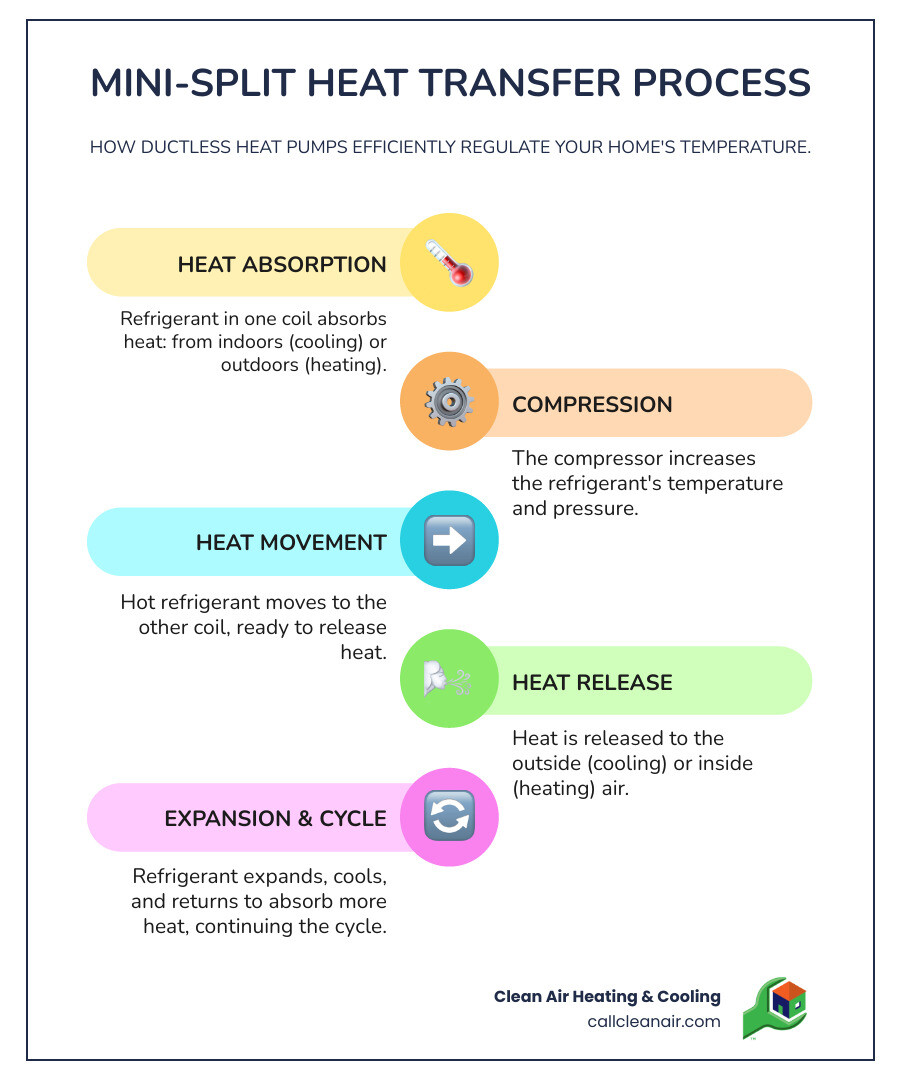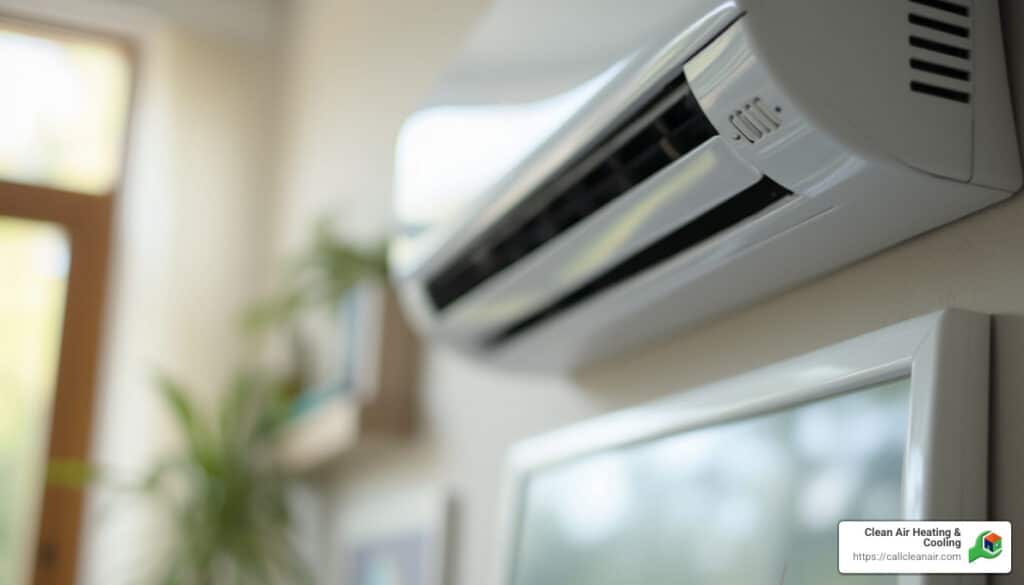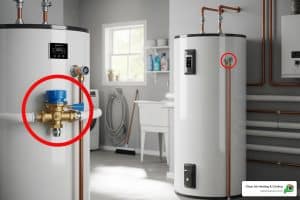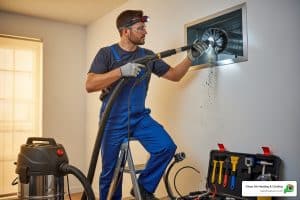The Average Mini Split Heat Pump Installation Cost
When you look into mini split heat pump installation cost, you’ll find the price varies based on system type, power (BTUs), energy efficiency (SEER/HSPF), and installation complexity. The total cost covers both the equipment and professional labor.
Mini-split heat pumps, also known as ductless systems, are an efficient way to heat and cool your home. They don’t create heat; they move it. In summer, they pull heat from inside and release it outdoors. In winter, they reverse the process, grabbing heat from the outside air to warm your home. A system consists of an outdoor condenser and one or more indoor air handlers connected by refrigerant lines, allowing for independent temperature control in different “zones.”

Nationally, most homeowners can expect the total installed cost to range from $3,500 to over $18,000. In Northwest Washington, including Whatcom and Skagit Counties, local labor rates and demand influence the final price.
Breakdown of the Mini Split Heat Pump Installation Cost
The total mini split heat pump installation cost is split between equipment and labor.
- Equipment Costs: Ranging from $1,500 to $5,000+, this depends on the unit type. Wall-mounted units are common ($400-$1,000 per head), while ceiling cassettes ($500-$2,000) or floor-mounted units ($1,300-$4,000) are other options.
- Labor Costs: Typically $2,000 to $5,000+, this covers the technician’s time. A single-zone installation might take 6-10 hours, but multi-zone systems or complex jobs take longer. For more details, see Our HVAC Pricing.
Single-Zone vs. Multi-Zone System Costs
A key cost driver is choosing between a single-zone or multi-zone system.
- Single-Zone Systems: With one indoor and one outdoor unit, they are ideal for a single room or area. Installed costs typically start around $3,500.
- Multi-Zone Systems: One outdoor unit connects to multiple indoor units for independent room control. Installed costs range from $5,000 to $8,000+, with each additional indoor unit costing $500 to $2,000.
Comparing Costs: Mini-Splits vs. Traditional HVAC
Compared to traditional central AC (average installation $5,800-$14,400), mini-splits can be more cost-effective, especially if your home lacks ductwork. Installing new ducts can add $2,500 to $5,000 or more to a central system’s cost. Mini-splits eliminate this expense, making them a great choice for homes without existing ducts, room additions, or converted spaces. For homes with functional ductwork, a traditional system might be a practical choice. Learn more about general heat pump costs here: How Much Is My New Heat Pump Really Going To Cost?.
Key Factors That Influence Your Final Price
The final mini split heat pump installation cost isn’t a single number; it depends on several key factors. Understanding these influences, from brand and quality to installation complexity, helps you budget accurately. Well-known brands like Mitsubishi and Fujitsu may have a higher starting price for their reliability, while others like Rheem or Pioneer might offer different value propositions. The right choice balances features, long-term savings, and your budget
System Capacity (BTU/Tonnage) and Sizing
A system’s power, measured in BTUs (12,000 BTUs = 1 ton), significantly affects your mini split heat pump installation cost. Correct sizing is crucial and goes beyond simple square footage, considering factors like ceiling height, insulation, and window efficiency. For example, a 12,000 BTU unit may suit a 400-600 sq. ft. space, while a 36,000 BTU unit is better for 1,500-2,000 sq. ft.
An undersized system will run constantly, increasing energy bills, while an oversized one will “short cycle,” wasting energy and creating uneven temperatures. A professional Manual J load calculation ensures your system is perfectly matched to your home for optimal comfort and efficiency. Learn more in our guide on What Size Mini Split Do I Need? or explore tools like the Manual J calculation tool.
Energy Efficiency Ratings (SEER, EER, HSPF)
Energy efficiency ratings are vital to understanding long-term savings.
- SEER (Seasonal Energy Efficiency Ratio): Measures seasonal cooling efficiency. Higher is better.
- HSPF (Heating Seasonal Performance Factor): Measures seasonal heating efficiency. Higher is better.
Systems with higher SEER and HSPF ratings have a higher upfront cost but lead to lower monthly utility bills. This initial investment often pays for itself over time. We recommend ENERGY STAR certified systems, which meet strict efficiency guidelines and may qualify for rebates. Learn more about HVAC Energy Savings and find ENERGY STAR certified systems.
Additional Installation Complexities and Costs
The mini split heat pump installation cost can increase due to necessary upgrades or complexities.
- Electrical Work: Many units need a dedicated circuit. If your panel needs an upgrade, this can add $500 to $2,000+.
- Line Set Length: If the distance between indoor and outdoor units exceeds the standard length, extra line sets can add $100 to $300 per additional foot.
- Other Potential Costs: These can include condensate drain pumps ($120-$280), wall brackets ($100-$210), permits ($250-$400), carpentry ($140-$600+), and old system removal ($80-$150).
A detailed, itemized quote is essential to avoid surprises. For more advice, see our Mini Split Installation Tips.
Maximizing Value: Savings, Rebates, and Long-Term Benefits
Investing in a mini-split heat pump goes beyond the initial mini split heat pump installation cost. It’s about long-term value from energy savings, improved comfort, and available incentives.
How to Save Money on Your Installation
Managing the mini split heat pump installation cost is a priority. Here are some strategies to save without sacrificing quality:
- Get multiple quotes: Compare detailed estimates from at least three reputable contractors.
- Schedule an off-season installation: Demand is lower in spring and fall, which may lead to better rates.
- Ensure proper sizing: A professional load calculation prevents energy waste and optimizes performance.
- Balance features and cost: Decide which advanced features you truly need to find a system that fits your budget.
Ready to explore your options? Request an HVAC Estimate from our team.
Washington State Rebates and Federal Tax Credits
Rebates and tax credits can significantly offset the mini split heat pump installation cost. These incentives encourage the adoption of energy-efficient systems. Homeowners may be eligible for federal tax credits, and various Washington State utility programs offer rebates. At Clean Air Heating & Cooling, we are familiar with the local programs available to residents in Whatcom, Skagit, Snohomish, San Juan, and Island Counties. We can help you steer opportunities like the PSE Heat Pump Rebate and other Washington Heat Pump Incentives. The Database of State Incentives for Renewables & Efficiency (DSIRE) is another excellent resource.
Long-Term Benefits of a Mini-Split System
The long-term benefits of a mini-split system are impressive and add to its overall value.
- Energy Savings: Zoned heating and cooling can reduce energy bills by up to 30%. The ductless design also prevents energy loss from leaky ductwork.
- Zoned Comfort: Set different temperatures in individual rooms for personalized comfort.
- Improved Indoor Air Quality: Multi-stage filtration systems reduce dust and allergens.
- Quiet Operation: Indoor units are whisper-quiet, operating as low as 32 decibels.
- Increased Home Value: An efficient, modern mini-split system is an attractive feature for potential home buyers.
DIY vs. Professional Installation: A Cost and Risk Analysis
When considering the mini split heat pump installation cost, the idea of a DIY installation to save on labor is tempting. However, what seems like savings can lead to larger expenses and headaches. Professional installation is a smart investment in your home’s comfort, safety, and the longevity of your system.
The Appeal and Pitfalls of DIY Installation
Saving on labor costs is appealing, but DIY installation is complex and carries significant risks:
- Specialized Tools: Installation requires expensive tools like vacuum pumps and micron gauges, which most homeowners don’t own.
- Refrigerant Leaks: Improperly flared lines can cause leaks, which are bad for the environment and system performance. Handling refrigerants also requires certification.
- Voided Manufacturer Warranty: Most manufacturers void the warranty if the system isn’t installed by a licensed HVAC professional.
- Improper Sizing: Guessing the unit size can lead to an inefficient system that is either overworked or short-cycling, wasting energy.
- Code Violations & Safety Hazards: DIY jobs often fail to meet local building codes, leading to fines and safety risks like electrical fires.
Why Professional Mini Split Heat Pump Installation Cost is a Worthwhile Investment
A professional installation might have a higher upfront mini split heat pump installation cost, but it provides long-term value and peace of mind.
- Warranty Protection: Professional installation ensures your manufacturer’s warranty remains valid, protecting your investment.
- Code Compliance: Our NATE-certified technicians are experts in local codes for Whatcom, Skagit, and surrounding counties, ensuring a safe and compliant installation.
- Optimal Performance: We guarantee proper sizing, refrigerant charging, and wiring, so your system runs at peak efficiency for maximum energy savings.
- Safety Assurance: Professionals are trained to handle electrical connections and refrigerants safely, protecting your home and family.
- Peace of Mind: With over 480 5-star Google reviews, our team at Clean Air Heating & Cooling provides expert Mini Split AC Installation Services that protect your comfort and investment.
Frequently Asked Questions about Mini-Split Costs
When considering the mini split heat pump installation cost, many questions arise. Here are answers to some of the most common ones we hear at Clean Air Heating & Cooling.
Can a mini-split cool or heat a whole house?
Yes, a mini-split system can heat and cool an entire house, but the approach depends on your home’s size and layout. For smaller homes or open-concept designs, a single multi-zone system can be effective. For larger homes (over 2,000-3,000 sq. ft.) or those with many separate rooms, more than one multi-zone system might be needed to ensure adequate comfort in every area. In some cases, especially for homes with existing ductwork, a traditional central HVAC system may be more practical. We will always assess your space to recommend the most sensible solution.
How long do mini-split systems last?
With proper care, a quality mini-split system can last 15 to 20 years, often outliving conventional central AC units. The key factors for longevity are:
- Professional Installation: Correct sizing, sealed connections, and proper refrigerant levels reduce wear and tear.
- Regular Maintenance: Monthly filter cleanings and annual professional inspections prevent small issues from becoming major problems.
- Quality Components: Reputable brands often use more durable parts, contributing to a longer lifespan.
Do I need an electrician to install a mini-split?
In most cases, yes, an electrician’s involvement is necessary. While our HVAC technicians handle the system connections, the outdoor condenser unit requires a dedicated power source. An electrician is needed to:
- Install a Dedicated Circuit: Most outdoor units require their own circuit to prevent overloading your home’s electrical system.
- Meet Voltage Requirements: Mini-splits often need a 220-volt or 240-volt circuit, which may not be readily available.
- Ensure Code Compliance: All electrical work must adhere to strict local safety codes.
We coordinate with qualified electricians to ensure every installation is safe, correct, and up to the highest standards.
Conclusion: Is a Mini-Split Right for Your Home?
Deciding if a mini-split is right for your home involves weighing the mini split heat pump installation cost against its significant long-term benefits. We’ve seen how factors like system size, number of zones, and efficiency ratings shape the price.
While the initial investment is a consideration, a mini-split system pays you back with years of superior comfort and efficiency. You’ll enjoy lower energy bills, personalized zoned heating and cooling, improved indoor air quality, and an increase in your home’s value.
At Clean Air Heating & Cooling, our passion is bringing peace of mind to our neighbors across Whatcom, Skagit, Snohomish, San Juan, and Island Counties. Our commitment to prompt, high-quality service is reflected in our 480+ 5-star Google reviews and our 25% utility savings guarantee. We are dedicated to finding the ideal solution that provides reliable comfort for years to come.
Ready to take the next step towards a more comfortable and energy-efficient home?
Get a professional quote for your ductless mini-split installation today!





